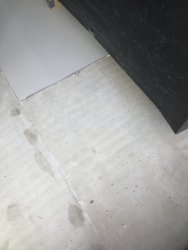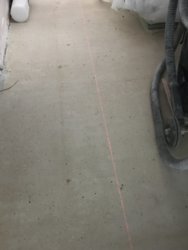O
Old Mod
You really do need to remove a tile to see what’s beneath.
The cracking sound is where the tile has de bonded from the floor.
It’s important now to determine what has de bonded. The tile from adhesive, or adhesive from floor.
That will narrow down your search for an answer.
The floor need sanding back to expose the aggregates to be 100% sure it’s been removed.
First two images have laitence still remaining on the failed floor, bearing in mind some has already been removed and some was stuck to the tile.




Enlarging the last image you can see the dark spots, that is the aggregates.
Can be done with a hand grinder but that’s quite an area for a small machine.
More typically a floor sander would be used.
(They look like an industrial cleaners buffing machine) but you would fit abrasive discs instead, around 60# grit.
And you need dust extraction.
You can see the quantity produced.
And priming is critical when using a cementitious adhesive on an anhydride floor.
2 coats is not necessarily enough.
And they should be applied perpendicular to each other.

The cracking sound is where the tile has de bonded from the floor.
It’s important now to determine what has de bonded. The tile from adhesive, or adhesive from floor.
That will narrow down your search for an answer.
The floor need sanding back to expose the aggregates to be 100% sure it’s been removed.
First two images have laitence still remaining on the failed floor, bearing in mind some has already been removed and some was stuck to the tile.




Enlarging the last image you can see the dark spots, that is the aggregates.
Can be done with a hand grinder but that’s quite an area for a small machine.
More typically a floor sander would be used.
(They look like an industrial cleaners buffing machine) but you would fit abrasive discs instead, around 60# grit.
And you need dust extraction.
You can see the quantity produced.
And priming is critical when using a cementitious adhesive on an anhydride floor.
2 coats is not necessarily enough.
And they should be applied perpendicular to each other.

